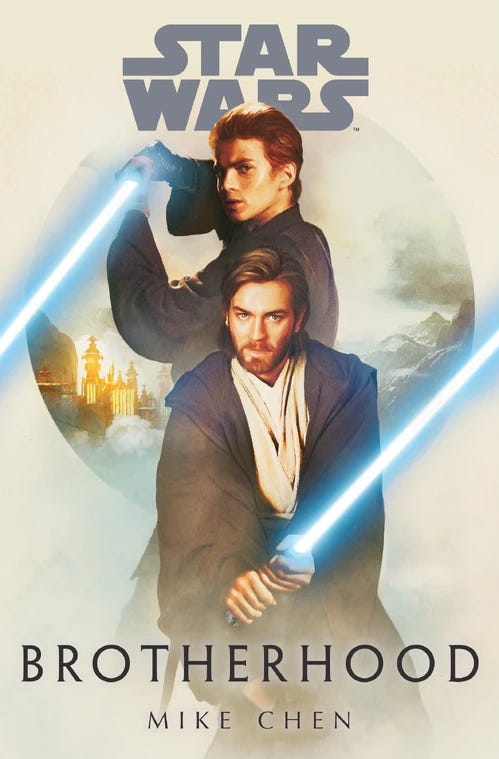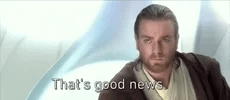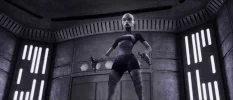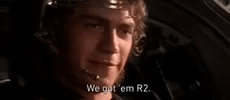My rating: 4/5
Pub Date: May 10, 2022
Legends/Canon: Canon
Timeline: 22 BBY
Welcome back to the Star Wars Book Club! I finally caught up with the hype and read Mike Chen’s Brotherhood. Read on for my spoiler free review.

Well, this was a Star Wars book. We got lightsabers, redirected blaster bolts, good plans gone bad, and plenty of politics. This book takes place right at the beginning of the Clone Wars, almost immediately after Attack of the Clones, which means the Republic and the Separatists are not getting along. Then throw the Trade Federation into the mix and we’ve got ourselves a whole slew of problems.
The one big problem that this book is focusing on is a bombing that takes place on Cato Neimoidia. This would be just another galactic tragedy, except for the fact that Cato Neimoidia is a neutral system affiliated with the Trade Federation. Their neutral status makes the bombing a big deal because it could potentially swing the whole planet politically one way or another. That’s why Obi-Wan is ultimately dispatched to investigate the bombing and be the politician he never really wanted to be, but always seems to get to be.
And that’s the basic plot of the book. A politically rife investigation. But most importantly this book is based off of one little line from the Revenge of the Sith movie: “That business on Cato Neimoidia doesn’t count.” The line is in reference to how many times Anakin has saved Obi-Wan’s life. The machinations behind this ‘life saving’ scenario are entering spoiler territory, so I’ll leave the plot alone for the rest of this review and talk about characters instead.
This book is called Brotherhood for good reason. Our main characters are Anakin Skywalker and Obi-Wan Kenobi, one of the most dynamic duos ever, and this book explores their relationship as it evolves from Master/Padawan to one of more equal footing after Anakin officially becomes a Jedi Master.
Speaking of Anakin and his life advancements, the first half of this book he was borderline obsessive about the fact that he and Padme are married. I guess I already knew that Anakin was emotionally compromised enough for Palpatine to turn him into Vader.
“He had been there for Anakin since his early days with the Jedi, seemingly always tuned in to Anakin’s turbulent feelings. In moments of loneliness or frustration, Palpatine popped up in the timeliest manner.” ~Mike Chen
But Brotherhood really dives deep into those turbulent feelings. So much so that I was somewhat annoyed by Anakin and his constant need to think about and remind himself about his feelings for Padme. He’s quite juvenile in that regard, and while it’s endearing in small doses, it gets boring after a while. Despite being annoying at times, I think this constant mentioning of his emotions is very purposeful on Chen’s part and absolutely a big part of Anakin’s character.
Obi-Wan, on the other hand, is as much Anakin’s opposite as he always is. This quote sums it up quite well.
“This was Skywalker and Kenobi as they should be: a team built on emotion and intellect, bravado and control, fire and ice. And despite no longer having the formal bond of Master and Apprentice, they would always be connected. In fact, they were better this way.” ~Mike Chen
That isn’t to say that Obi-Wan doesn’t have his moments of bravado, some of which are directly influenced by his time with Anakin. It’s fun to read books like this and see exactly how the characters influence each other. Anakin has his moments where he thinks like Obi-Wan, and even more fun is when Obi-Wan decides to channel some of Anakin. That’s what their brotherhood is all about.
Strangely enough, my favorite part of this book wasn’t the brotherhood at all, it was the side characters. I’ve mentioned before that I love Ventress as a villain, so having her in this book was so much fun for me, and the youngling Mill Alibeth was an amazing inclusion. This is the first time Obi-Wan and Anakin face down Ventress, and her craftiness really gave them trouble. It was great.
Mill Alibeth is a youngling on the verge of getting a lightsaber. She’s also nearly crippled by her ability to sense violence and pain through the Force. She fears the Force and is desperately trying to shut herself off from it. Cue Anakin and his new Jedi Master duty of interacting with and teaching a group of younglings. Mill is, of course, in this group, and Anakin sees in her the same kind of emotional turmoil he feels himself. Thus begins my favorite little side plot maybe ever: Anakin mentoring Mill. For all the complaining I like to do about Anakin, he showed so much maturity when dealing with Mill. He truly wants what’s best for her, and seeing this compassionate side of Anakin was a highlight throughout the book. Mill, for her part, has some amazing character growth as she learns to use the Force instead of fear it. She’s just the sweetest little thing, and I would love to read a story all about her.
Lastly, I want to say that the references to other Star Wars books were so good! The sun-dragon heart of Anakin from the Revenge of the Sith novel was a great addition. It made Anakin feel so familiar and consistent across the books, which is amazing. The other big reference I noticed was Mace Windu and his shatterpoint sensing. That was timely and exciting to see considering how much I enjoyed reading Shatterpoint a few weeks ago. Mostly it’s amazing how much work goes into these books to make sure the cannon lines up and that the characters are consistent. I’ve read enough Star Wars at this point to start recognizing some of the smaller details across the expanded universe and that’s fun.
Thanks for reading! Share this with any Star Wars loving friends and leave any comments or questions down below.






